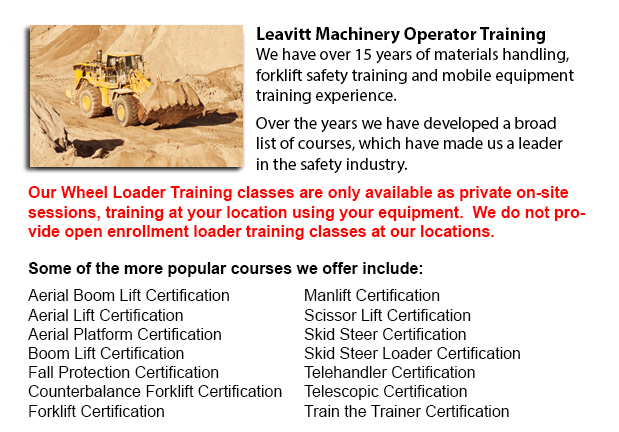
Barrie Wheel Loader Operator Training - Cranes are industrial machinery which make use of pulleys or levers to be able to lift substantial loads. The Roman people used cranes in order to construct big monuments, meaning these equipment have been around for at least 2,000 years. Numerous Medieval churches used cranes in their construction as well as the Egyptians might have relied on them when building the pyramids.
The modern kind of a crane can be either simple or complex, and cranes differ based on their use. Mobile cranes, for instance are rather simple. A steel truss or telescopic boom mounts its movable platform. A system of levers or pulleys raises the boom and there is normally a hook hanging. These cranes are frequently intended for demolition or earthmoving by changing the hook out with another piece of device like for instance a wrecking ball or a bucket. Telescopic cranes have a series of hydraulic tubes which fit together to form the boom. These units can likewise be mobile.
Both traditional or specialized wheels can be meant for railroad track or caterpillar track enabling these boom trucks to move on upaved and uneven surfaces.
Truck mounted and rough terrain cranes are even mobile with outriggers positioned on the truck mounted unit improve stability. On the other hand, rough terrain cranes include a base which tends to resemble the bottom of a 4-wheel drive. These cranes are equipped to be able to work on rough ground making them perfect in the construction trade for example.
Normally utilized on railroads and in ports, the Gantry crane could transport and unload big containers off ships and trains. Their bases include very big crossbeams that run on rails in order to raise containers from one location to another. A portainer is a special kind of gantry that transports supplies onto and off of ships specifically.
Floating cranes are attached on pontoons or barges and are another essential piece of machinery vital to the shipping industry. As they are located in water, they are meant for a variety of services consisting of port construction, building bridges and salvaging ships. Floating cranes could handle extremely heavy loads and containers and like portainers, they could likewise unload ships.
Loader cranes are fit onto trailers utilizing hydraulic powered booms so as to load supplies onto a trailer. While not in use, the jointed parts of the boom can be folded down. This type of crane could be even considered telescopic since one section of the boom could telescope for more versatility.
Usually utilized in automated warehouses, stacker cranes tend to follow an automatic retrieval system and could function utilizing a remote. These cranes are equipped along with a forklift apparatus and can be found in large automated freezers, stacking or obtaining food. Utilizing this kind of system enables workers to remain out of that cold setting.
Tower cranes are frequently the tallest cranes and typically do not have a movable base. They must be put together piece by piece. Their base is similar to a long ladder along with the boom at a 90 degree angle to the base. These cranes specialize in the construction of tall structures and are normally affixed to the inside of the building itself all through the construction period.
-
Barrie Warehouse Forklift Safety Training
Barrie Warehouse Forklift Safety Training - Businesses normally face liability for injuries and damage sustained in workplace accidents. Warehouses can be hazardous places to the individuals who work there. That is the reason why employee safety is a... More -
Barrie Aerial Platform Training
Barrie Aerial Platform Training - Aerial lifts can accommodate many duties involving high and tricky reaching places. Normally used to carry out regular upkeep in buildings with high ceilings, prune tree branches, hoist heavy shelving units or mend p... More -
Barrie Forklift Ticket
Barrie Forklift Ticket - Pallet jacks and lift trucks are both intended for practically the same reason; to transfer goods from one location of your warehouse to another. This is basically where the comparison stops however. With the pallet jack, the... More -
Barrie Aerial Lift Training
Barrie Aerial Lift Training - An aerial work platform is a mechanized access platform. This machinery provides access to otherwise not accessible places for people or equipment. Also referred to as an aerial device or elevating work platform, the mac... More -
Barrie Aerial Boom Lift Training
Barrie Aerial Boom Lift Training - For people who operate or supervise the use of aerial lift platforms, correct aerial boom lift Training is required. The aerial lift platform is utilized for lifting individuals, tools and materials to elevated work... More -
Barrie Manlift Certification
Barrie Manlift Certification - The Elevated Platforms and Manlifts Certification program helps to provide the needed training on the work practices, safe operating procedures, rules and regulations regarding the everyday activities for the operators... More -
Barrie Overhead Crane Certification
Barrie Overhead Crane Certification - The overhead crane training certification course is designed to be effective with all participants regardless of literacy or language limitations. The course has two parts: a classroom training session and a prac... More -
Wheel and Track Loader Training in Barrie
Lift trucks are obtainable in several various units that have varying load capacities. The majority of typical lift trucks utilized in warehouse settings have load capacities of one to five tons. Bigger scale models are used for heavier loads, such a... More

Forklift Certification Barrie
TOLL FREE: 1-888-254-6157
Barrie, Ontario
forkliftcertificationbarrie.com
Email Us
About Us


